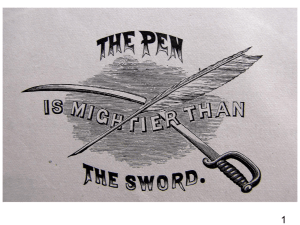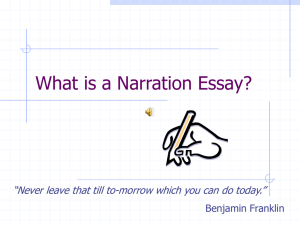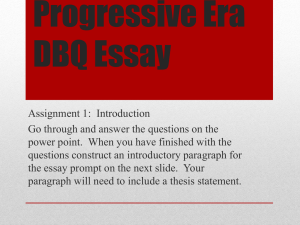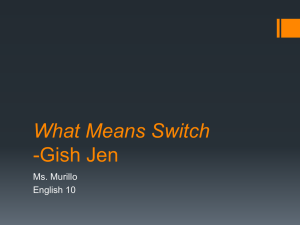How to Write a Literary Essay
advertisement
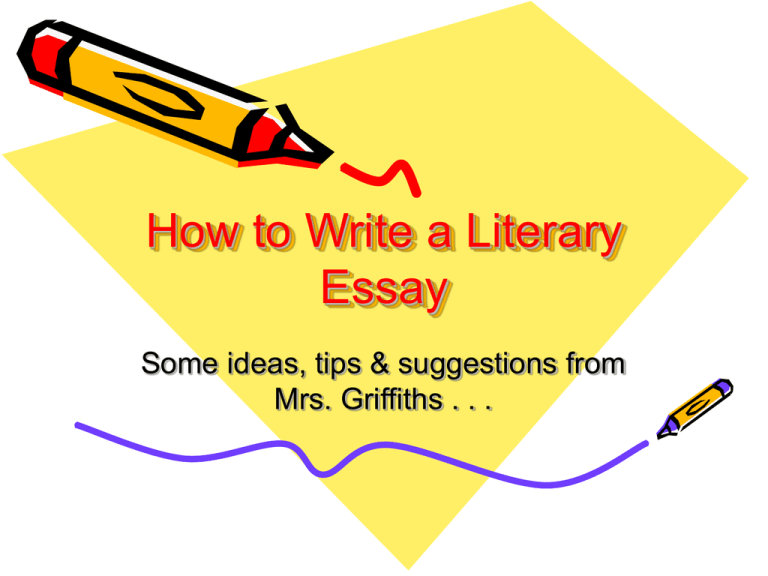
How to Write a Literary Essay Some ideas, tips & suggestions from Mrs. Griffiths . . . Why do we have to write essay papers in English class? • 1) Writing is a part of everyday life, especially if you are planning to attend university, college or any post secondary school. You will be asked, more than once, to write an essay in any course you attempt. • 2) If you do not plan to further your education, chances are you will have to write some sort of essay-type report in the excellent, well-paying job you will land in the future. • 3) There is an essay question on your final examination. • 4) Possibly the most important reason… to pass English class! The Purpose of an Essay Students write literary essays as a response to a piece of literature they have read. Usually, they take a position on a topic and then try to prove their stance to the reader. When writing an essay, the writer follows this basic pattern: • • • SAY IT SHOW IT SAY IT AGAIN An essay has a Beginning, a Middle and an End. Beginning = Introduction = SAY IT Middle = Body = SHOW IT End = Conclusion = SAY IT AGAIN The Beginning (SAY IT) This is your introductory paragraph. Begin with a general discussion of your topic. Move to a specific thesis. Your THESIS is the “SAY IT” part. It is the statement that you are going to prove in your essay. The Middle (SHOW IT) This middle is referred to as the BODY of the essay Your body paragraphs need to provide specific evidence to actually SHOW or PROVE the thesis that you created in your introduction. Use as many body paragraphs as you need to prove your thesis. The End (SAY IT AGAIN) This is your concluding paragraph. You need to summarize the argument that you proved in your essay. That is, say your thesis again. You need to end with a general conclusion that explains what you have learned from writing your essay. So, let’s look at each of the parts of an essay in a little more detail . . . The typical 5 Paragraph Essay looks like this: Paragraph 1 INTRODUCTION (+ THESIS) Paragraph 2 PROOF for your thesis Paragraph 3 MORE PROOF for your thesis Paragraph 4 EVEN MORE PROOF for your thesis CONCLUSION (summary) Paragraph 5 Your THESIS is your answer to the question that was asked; that is, it is the position you want to argue (prove). Each paragraph you write in your essay is there to provide back-up (proof) for the position (thesis) that you have taken. An example of a thesis: Teacher’s question: “Some people believe that Piggy is the true hero of the novel Lord of the Flies.” Agree or disagree with this statement. Student’s thesis (position): Ralph is often labeled as the hero of Lord of the Flies; however, the true hero of the novel is the much understated character, Piggy. Presenting a thesis: There are a few different ways that you can present a thesis statement . . . 1) You can write a sentence that has the three points in it which you will argue in your paper. Ex: In Lord of the Flies, the characters Jack, Ralph and Piggy all contribute to the destruction of the island. 2) You can write a sentence that has an overarching idea in it that you will try to prove. Ex: Mankind’s innate tendency toward evil actions is the true cause for the destruction of the island in the novel, The Lord of the Flies. The Introduction An introduction should always include basic information about your topic. When writing about a literary work it is important to include the title and the author of the work somewhere in the introduction. The most important part of an introduction is the THESIS STATEMENT. A thesis statement is the sentence that is based around the idea(s) that the paper is going to prove or focus on. Effective Hooks The introduction is the place where the writer needs to grab the reader’s attention. This may be done several ways: A striking METAPHOR or COMPARISON, ex: Like the serpent in the garden of Eden, the evil nature of the boys is far too tempting for them to overcome. A QUOTATION, ex: “The conservative sees the inner unremovable nature of man as the ultimate source of evil” (Bartlett’s Quotations, online). A CONTROVERSIAL STATEMENT or a STARTLING STATISTIC, ex: Young boys are very capable of one thing—destruction. A RHETORICAL QUESTION, ex: Did the boys really stand any chance of surviving, unscathed, their time on the island? Never . . . • Announce your intentions…never state out right that you are about to write an essay. Ex: In this essay I will… In my paper I will talk about … The purpose of this essay is to … Always. . . Use TRANSITIONS. The last line of your introduction needs to move the reader to the main body of your essay. Quite often, this is where we place the THESIS because is clarifies the question that the topic asks. Body Paragraphs • Each body paragraph has to play its part in SHOWING or PROVING your thesis. • Each body paragraph follows the same SAY IT, SHOW IT, SAY IT AGAIN structure that the essay follows as a whole. • In order for the body of your paper to support your thesis in a meaningful way, one must use Topic Sentences and StatementIllustration-Relation to make your arguments. A good body paragraph will have a Beginning, a Middle, and an End. The Beginning = Topic Sentence = SAY IT (Statement) The Middle = Examples/Evidence/ Explanations = SHOW IT (Illustration) The End = Concluding Sentence = SAY IT AGAIN (Relation) Topic Sentences Topic sentences serve two purposes that largely provide structure and organization to your essay. The first purpose is to directly support the thesis statement. The topic sentence should provide a strong argument for the idea(s) the essay is trying to prove. The second purpose of the topic sentence is to provide the reader with an idea of what your entire paragraph will be about. Each sentence that you write in the paragraph should directly relate back to the topic sentence somehow. The S-I-R Essay Method S-I-R is a three part process that helps you make your argument. S = Statement (point you want to make) I = Illustration (example/quote from novel) R = Relation (explanation + connection to your thesis) Each paragraph follows a very simple pattern: Statement: A supporting point you want to make that backs-up your thesis statement. Illustration: Proof from the novel that supports your point. The more proof you have, the more likely someone will believe you. Proof may take the form of a direct quotation, or a paraphrase (putting ideas/ actions/descriptions in your own words). Always follow a quote with an explanation of the key points found in it that support your thesis. Never end a paragraph with a direct quotation—always add at least one more sentence to explain the importance of the quotation you have chosen. Relation: Think back to what you are trying to prove in this essay—how does the topic of this paragraph add to your position. Sum-up/repeat the key point that was stated in your topic sentence. The more well-structured paragraphs you have like this , the stronger your essay will be. Always stay on topic, answer the question asked and avoid just re-telling the story. Conclusion A conclusion’s general purpose is to wrap up your argument. An effective conclusion should: 1. Restate your thesis. 2. Summarize the strongest points or arguments of the paper. 3. Close out with a final, profound thought. This is the way the world ends This is the way the world ends This is the way the world ends Not with a bang but with a whimper. ~T.S. Eliot What T.S. Eliot says about the ending of the world is, alas, only too true of the endings of some student essays. Here are a few pitiful “whimpers” I’ve read lately: • In conclusion, I have told you in this essay about the symbols in Macbeth. • To sum up, Piggy was a heroic character in this novel. • To conclude, Shakespeare is a great author and I enjoyed his play very much. Here are some strategies for ending an essay effectively: A QUOTATION, especially from some authority connected with the topic you are discussing. Ex: To sum-up the uncontrollable nature of the boys, Golding has stated, “Childhood is a disease—a sickness that you grow out of” (Bartlett’s Quotations, online). A QUESTION or a CHALLENGE. Ex: Unbelievable, one may think, that the boys could be capable of such savagery? Then perhaps one should look a little deeper into his/her own psyche. A RETURN TO THE THESIS and a RESTATEMENT of it in an interesting way. (This is probably the most common way of concluding.) Ex: It is no longer a question of “if”, but, rather, a statement of “then” Piggy is, undoubtedly, the true hero of the novel once all of the evidence has been examined. Always remember to use transitions in your ending, ie: therefore, hence, clearly, indeed. More Ideas on Your Conclusion: “Finally, the fifth paragraph is the summary paragraph. It is important to restate the thesis and three supporting ideas in an original and powerful manner as this is the last chance the writer has to convince the reader of the validity of the information presented. Because the purposes of the first and fifth paragraph are so similar, some writers construct them at the same time. They will edit them, as necessary, as they do with each and every part of the essay.” www.geocities.com/SoHo/Atrium//1437/structure/html Good Things to Know . . . Before Writing: • You need to always fully understand what you are expected to do . . . if in doubt, ask the teacher. • You also need to decide if your paper is supposed to be a general overview on a topic, or an answer to a specific question. Next comes the Brainstorm... By now you should all know the basic ideas of the brainstorm....but just incase.... http://www.atpm.com/7.03/ images/inspirationBrainstorming.gif Essay Outline It is a good idea to outline the main points that you will use in your essay. (Take these from your brainstorming bubble.) In your outline include a topic sentence for each paragraph of the body, along with 1 to 3 quotations that illustrate the points you wish to make. Also, include a solid thesis statement to work from. Sample Outline INTRODUCTION Hook: Thesis: BODY 1 Topic Sentence: Support: BODY 2 Topic Sentence: Support (cont.) BODY 3 Topic Sentence: Support: CONCLUSION: (This is very simplified.) Citing Sources: • • • • A bibliography always starts on a new page. The title is centred. Double-space between title and first entry. Each entry begins flush with the left margin, and is then indented ½ an inch. • Entries are single-spaced, with a blank line between entries. • Alphabetize the list by author. • Include only sources you have used in your paper. MLA Format: From a Book Author(s). Title of book. Place of publication: Publisher, date. From the Web Author(s). “Title of Article”. Date retrieved, from (Web address). If you use other types of sources, check out how to cite them here: http://essayinfo.com/citations/mla.php Using an In-text Citation: An in-text citation allows you to use a quote from any source, in your essay, without plagarizing from some one’s work. What you need to know is how you do it. Here is an example . . . . . . while looking at the moon in the sky does not cause the same amount of damage to the eyes that the sun does, it does, however, cause the eyes to “. . . close and open very fast allowing limited light to get to the inner eye” (Norman, 37). Therefore, you will probably get bored before you ever went blind. The next thing to consider is the fact that the . . . Things to Remember: If the quote is longer than four lines long, then it must be written as follows: . . . Your essay is being written here and then you, want to put a quote in that is more than four lines of text long. You need to indent it like this, and cite it the same way as you do a short quote. The four lines would be four lines of typed text (Norman, 124). Include only important parts of longer quotations. Use ellipses (…) to remove irrelevant or less important parts of very long quotes. Always follow the quote with (author, pg. #). Note that the period comes at the very end of the sentence—after the reference information. Always introduce your quotation. Do not just “plunk” a quote into the body of your essay. Use a few words to lead into to it, such as: . . . when the author states, “cats are better than dogs” (Norman, 22). . . . an example of this occurs when Ralph says, “-----” (Golding, 45). In addition, the boys: “-------” (Golding, 78). The author notes, “-------” (135).




